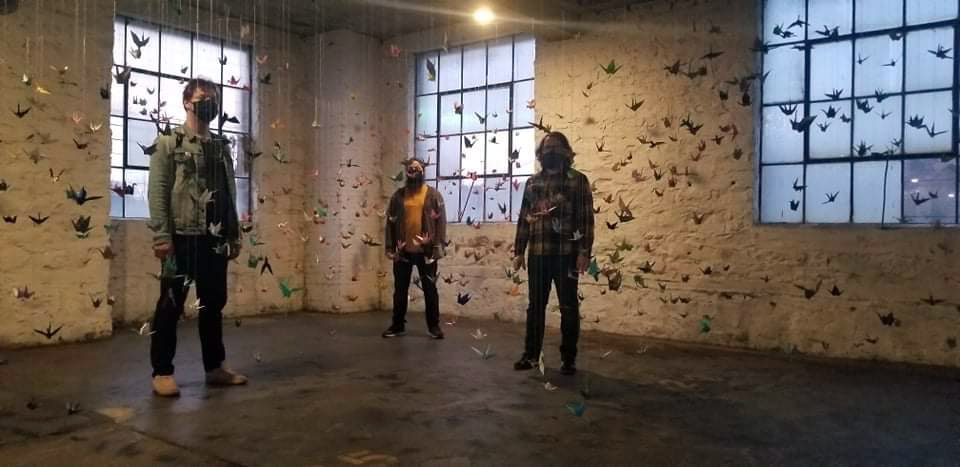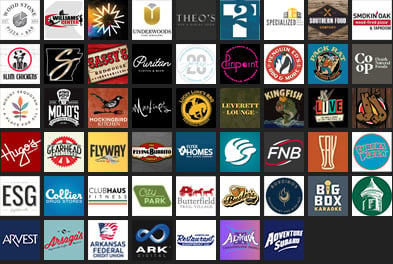
Nosferatu live scoring photo by Bo Counts
Last November in the garage of Likewise Community, local new music ensemble Thought Form Collective performed a live improv score to F. W. Murnau’s silent film classic Nosferatu: Symphony of Horror first released in 1922.
Thought Form’s expansive percussive palette of textures and eerie synth sounds reverberated through the concrete space for an otherworldly transformation of the film, an unofficial and unauthorized German expressionist horror film adaptation to Bram Stoker’s Dracula.
The entire experience was recorded, which means Trillium Salon Series is bringing the experience directly to audiences via a YouTube premiere at 8 p.m. this Friday, Oct. 29. Catch the premiere online and sign up for Trillium Salon invites to know about more one-of-a-kind experiences that redefine the live music experience.
Ahead of the screening, I caught up with Thought Form Collective about the experience of creating a live improv score and what’s in store for this new music ensemble.
How did Thought Form Collective come together as a group and what were the uniting principals that served as the starting place for the group?
Drew Morris (piano/trumpet/percussion) and Chris Scherer (percussion) met when Morris gave a presentation for a percussion methods class at the University of Arkansas in 2018. We talked about wanting to start a new music ensemble, particularly to play and commission music by living composers, especially people that Drew had connected with on Twitter, and to push the boundaries of contemporary classical music and to bring more of it to NWA. The plan was to have a fluid network of musicians depending on what the music we were playing called for, thus the ‘Collective’. We knew we would have a heavy emphasis in percussion, but it was always going to be open instrumentation. We added Jacob Arnold (percussion/cello) and Jay Shepherd (guitar/bass/low brass) and started rehearsals in early 2019. We played existing works from composer friends of ours, wrote some of our own pieces, and even covered a tune by Square Peg Round Hole. One of the first tunes we really got into was CD+DK by Olivia Kieffer, originally for two synthesizers that we made our own for vibes, drums, guitar, and synth in sort of a rock band setup. On the same gig, we also played “A Series of Harmonies” by Anthony R. Green, which is the most chill, ambient piece in stark contrast to our interpretation of CD+DK. After working through some of these tunes we put in a grant application to the opening of the Wilson Springs Preserve and were selected, and we began putting together that whole thing: a one hour immersive percussion experience in the woods, played almost entirely on found/reused objects. We also recruited several other musicians for that performance. We recruited Carson Vanduch, Tanna Waltman, and Logan West (percussion) to fill out the 6 parts. After that we started experimenting with using chance to determine our music (both in composition and live during the performance – rolling dice on drums) and pushing boundaries in other ways with electronics. We haven’t quite settled into a ‘niche’ and seem to find ourselves drawn in several directions at any given time. Currently, the primary personnel are Drew, Chris, and Carson, playing mostly percussion and electronics/synth.
What drew you into Nosferatu?
It’s a classic silent film and accessible to modern audiences. It fit the sounds we were being drawn to at the time. It was also the perfect length at 90 minutes; long enough to be a stand-alone performance but not way too long for audiences to sit through.

Photo by Brooke Aldridge
How did you plan the improvisation for the film? Was there an underlying arc to the live scoring?
We watched it a few times on our own to familiarize ourselves with the timing. We talked through the story and identified key moments that we wanted to have an impact of some kind, though we didn’t plan anything specific. We came up with some ideas for motives and themes to fit certain characters or events, such as the recurring descending minor third C-A, that then became standalone ideas and worked into the improvisation. We then spent time playing through parts of the film with various instruments and finalized our setups as we came up with sounds that we thought fit the film and our inspiration. We played all the way through the film a few times in ‘rehearsal’ to get a feel for the process and it was different every time. It would be cool to do it again, now a year after the fact, and see how much might be different.
What was it like to perform this live score? I believe it was the first performance you’d had in a good while?
We had a lot of uncertainty going in. It had been postponed a couple of times due to weather, we weren’t sure what to expect as far as how our sound would work in a mostly enclosed parking garage, and we weren’t sure how people would react. Ninety minutes is a lot of time to sit through percussion and electronic music and we had never done something of this magnitude before. We spent the entire day of the show getting everything loaded in and set up – a van full of percussion equipment as well as our audio and video equipment and a few instruments in the back of Drew’s truck. And then getting the electronics set-up and troubleshooting. We ended up making a trip to Guitar Center and a trip to Radio Shack to get everything working properly. Once we were ready to go, it seemed like it went by so fast, it was such a joy to make music from scratch and feed off of each other’s energy. We had a couple of surprise moments from the electronics, but everything went really well. I remember at the end the audience applauded and it sounded so strange because we were so used to livestreams at that point and hadn’t heard live applause in quite some time. It was incredible.
What did you learn about Thought Form Collective by doing this project?
At that point in time, we hadn’t done a show that was 100% improvised. We had done a lot of improv and experimentation with electronics and effects in our rehearsal space during the first half of 2020 and we had done some shorter staged improvised work at previous gigs, but nothing of this scale. This solidified our confidence as a group that does a lot of experimentation and improvisation, both acoustic and electronic. We also learned that we have much longer attention spans than we previously thought, both collectively and individually. Joking aside, we hadn’t performed anything longer than 25 minutes, and nothing that requires that much sustained focus. Immerse was aleatoric, and had some improv, but it was very planned out, and mostly the same groups of cells played over and over. Our performance with Nosferatu was a major achievement and we can’t wait to do it again with another film.
What are your plans for the coming year? How have you dealt with the pandemic?
Plans for the coming year? Mostly existential dread. In all seriousness though, we’ve been fairly quiet lately as far as performances go. We’ve been busy with other jobs and gigs, but we haven’t put Thought Form aside. We’ve been working on some new music and are planning some recording projects such as the duet we recently commissioned from Kimberly Osberg. It is a piece for tuned gongs and various other mainly metallic percussion instruments called “GOiNG MEnTAL.” It is in 3 movements and it kind of traces our lives through our times in lockdown. We’ve been working through it bit by bit in hopes of debuting it soon. We don’t have any major performance or release dates set in stone at the moment, but we’re hoping to nail that down soon.
As far as the pandemic goes, after the initial surge, we began meeting again and rehearsing and experimenting in our space, and it really helped us develop as a group. We ended up playing a junk percussion show in late July 2020 in the parking lot behind Pinpoint to celebrate their reopening and the beginning of the outdoor refreshment area downtown. After Immerse, we felt right at home playing junk percussion in a parking lot. We reprised some tunes from Immerse and wrote a couple originals and even played on some empty beer kegs. Then the next step was to play Nosferatu in the Likewise parking garage, and then another percussion improv gig there for the opening of the “1000 cranes for peace” installation. I think our music might be more at home in these unusual spaces rather than in a concert hall or standard venue, though we aren’t opposed to playing in those spaces. We also performed and talked about chamber percussion music and found instruments for the University of Arkansas Virtual Day of Percussion this past spring, which was broadcast live from the Faulkner Performing Arts Center. By far the nicest and most air conditioned venue we’ve played in so far. I think the most significant change was figuring out how to social distance our setups. Previously we had played a lot of shared instruments and we had to rework some of our pieces so that we had separate stations.

